Top speed 2,132 km/h Wingspan 17 m Length 30 m | Range 7,081 km Cruise speed 982 km/h Unit cost 12,440,000–12,440,000 USD | |
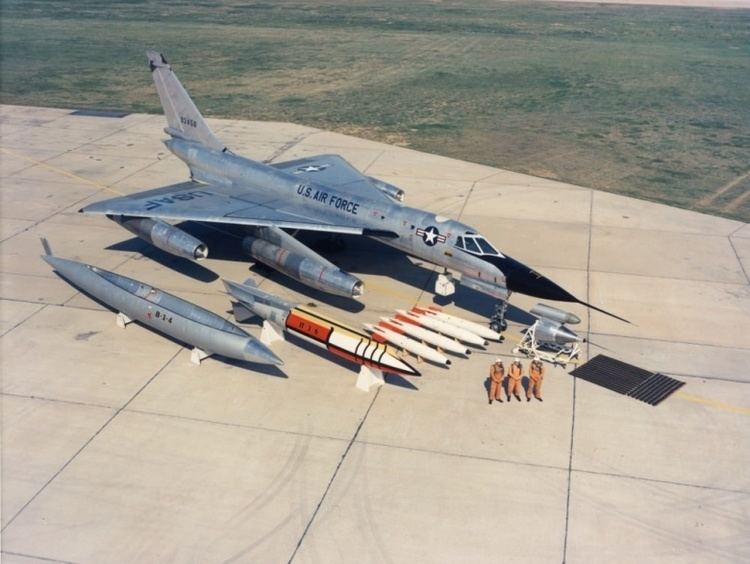 | ||
Strategic air command convair b 58 hustler film tall man five five 72012
The Convair B-58 Hustler was the first operational jet bomber capable of Mach 2 flight. The aircraft was designed by Convair engineer Robert H. Widmer and developed for the United States Air Force for service in the Strategic Air Command (SAC) during the 1960s. It used a delta wing, which was also employed by Convair fighters such as the F-102, with four General Electric J79 engines in pods under the wing. It carried five nuclear weapons; four on pylons under the wings, and one nuclear weapon and fuel in a combination bomb/fuel pod under the fuselage, rather than in an internal bomb bay.
Contents
- Strategic air command convair b 58 hustler film tall man five five 72012
- Convair b 58 hustler
- Design and development
- Weapons systems
- Operational history
- Excessive program expenditure
- Adverse flight characteristics
- Operational wings and retirement
- Test aircraft
- World records
- Variants
- Operators
- Aircraft on display
- Specifications B 58A
- Notable appearances in media
- References
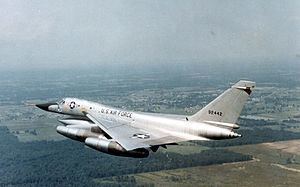
Replacing the Boeing B-47 Stratojet medium bomber, it was originally intended to fly at high altitudes and supersonic speeds to avoid Soviet fighters. The B-58 received a great deal of notoriety due to its sonic boom, which was often heard by the public as it passed overhead in supersonic flight.
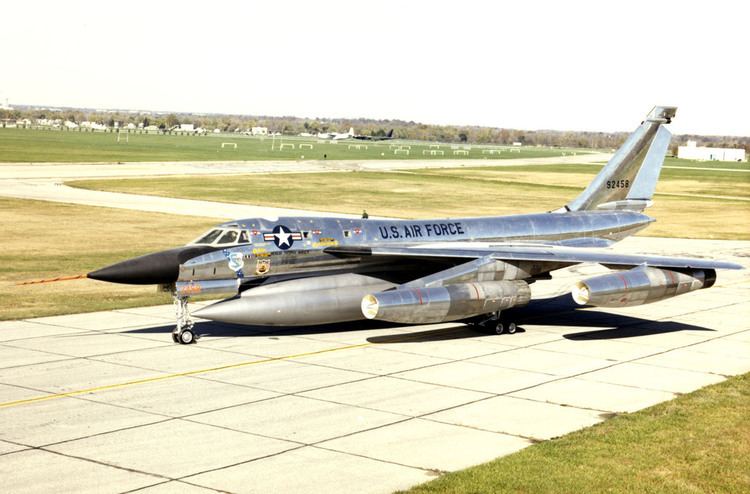
The introduction of highly accurate Soviet surface-to-air missiles forced the B-58 into a low-level penetration role that severely limited its range and strategic value, and it was never employed to deliver conventional bombs. This resulted in only a brief operational career between 1960 and 1970 when the B-58 was succeeded by the smaller, swing-wing FB-111A.
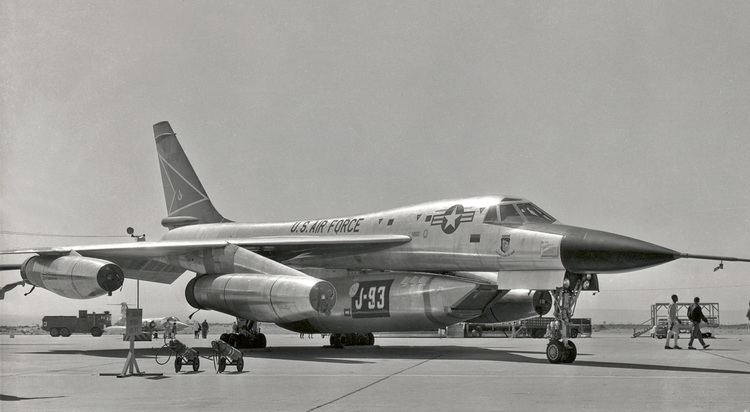
Convair b 58 hustler
Design and development
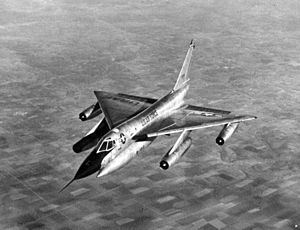
The genesis of the B-58 program came in February 1949, when a Generalized Bomber Study (GEBO II) had been issued by the Air Research and Development Command (ARDC) at Wright-Patterson AFB, Ohio, for the development of a supersonic, long range, bombardment aviation platform. The proposed bomber's design and development was to begin less than two years after sustained supersonic flight had successfully been achieved. A number of contractors submitted bids to perform the generalized study (that hopefully would lead to a development contract) including Boeing, Convair, Curtiss, Douglas, Martin and North American Aviation.

Convair, building on its experience in earlier delta-wing fighters, beginning with the XF-92A, a series of GEBO II designs were developed, initially studying swept and semi-delta configurations, but settling on the delta wing planform. The delta planform had good internal volume for support systems and fuel; plus a low wing loading (for airframe size), that permitted supersonic flight in the mid-stratosphere (50 - 70,000 feet). The final Convair proposal, coded FZP-110, was a radical two-place, delta wing bomber design powered by General Electric J53 engines. The performance estimates included a 1,000 mph (1,600 km/h; 870 kt) speed and a 3,000 statute mile (4,800 km; 2,600 nmi) range.
The USAF chose Boeing (MX-1712) and Convair to proceed to a Phase 1 study. The Convair MX-1626 evolved further into a more refined proposal redesignated the MX-1964. In December 1952, the Air Force selected the MX-1964 as the winner of the design competition to meet the newly proposed SAB-51 (Supersonic Aircraft Bomber) and SAR-51 (Supersonic Aircraft Reconnaissance), the first General Operational Requirement (GOR) worldwide for supersonic bombers. In February 1953, the Air Force issued a contract for development of Convair's design.
The resulting B-58 design was the first "true" USAF supersonic bomber program. The Convair design was based on a delta wing with a leading-edge sweep of 60° with four General Electric J79-GE-1 turbojet engines, capable of flying at twice the speed of sound. Although its large wing made for relatively low wing loading, it proved to be surprisingly well suited for low-altitude, high-speed flight. It seated three (pilot, bombardier/navigator, and defensive systems operator) in separated tandem cockpits. Later versions gave each crew member a novel ejection capsule that made it possible to eject at an altitude of 70,000 ft (21,000 m) at speeds up to Mach 2 (1,320 mph/2,450 km/h). Unlike standard ejection seats of the period, a protective clamshell would enclose the seat and the control stick with an attached oxygen cylinder, allowing the pilot to continue to fly even "turtled up" and ready for immediate egress. The capsule would float, and the crewmember could open the clamshell, using it as a life raft. In an unusual test program, live bears and chimpanzees were successfully used to test the ejection system. The XB-70 would use a similar system (though using capsules of a different design).
Because of heat generated at Mach 2 cruise, not only the crew compartment, but the wheel wells and electronics bay were pressurized and air conditioned. The B-58 utilized one of the first extensive applications of aluminum honeycomb panels, which bonded outer and inner aluminum skins to a honeycomb of aluminum or fiberglass.
The pilot's cockpit was fairly conventional for a large multiengine aircraft. The electronic controls were ambitious and advanced for the day. The navigator and DSO's cockpits featured wraparound dashboards with warning lights and buttons, and automatic voice messages and warnings from a tape system were audible through the helmet sets. Research during the era of all-male combat aircraft assignments revealed that a woman's voice was more likely to gain the attention of young men in distracting situations. Nortronics Division of Northrop Corporation selected actress and singer Joan Elms to record the automated voice warnings. To the men flying the B-58, the voice was known as "Sexy Sally."
Weapons systems
The Sperry AN/ASQ-42 bombing/navigation system combined a sophisticated inertial navigation system with the KS-39 Star tracker (astro-inertial navigation system) to provide heading reference, the AN/APN-113 Doppler radar to provide ground speed and windspeed data, a search radar to provide range data for bomb release and trajectory, and a radar altimeter. The AN/ASQ-42 was estimated to be 10 times more accurate than any previous bombing/navigation system.
Defensive armament consisted of a single 20 mm (0.79 in) T-171E-3 rotary cannon with 1,200 rounds of ammunition in a radar-aimed tail barbette. It was remotely controlled through the Emerson MD-7 automated radar fire-control system only requiring the DSO to lock-on a selected target blip on his scope and then fire the gun; the system computing all aiming, velocity or heading differential, and range compensation. Offensive armament typically consisted of a single nuclear weapon, along with fuel tanks, in a streamlined MB-1C pod under the fuselage. Incurable difficulties with fuel leakage resulted in the replacement of the MB-1C with the TCP (Two Component Pod), which placed the nuclear weapon in an upper section while the lower fuel component could be independently jettisoned. This had the added benefit of allowing the pilot to "clean up" the aircraft for fuel efficiency or in case of emergency, while still retaining the (somewhat) more slim weapon.
The first prototype, serial number 55-660, was completed in late August 1956. The first flight took place in November 1956. A difficult and protracted flight test program involving 30 aircraft continued until April 1959. The final B-58 was delivered in October 1962.
From 1961 to 1963, the B-58 was retrofitted with two tandem stub pylons under each wing root, adjacent to the centreline pod, for B43 or B61 nuclear weapons for a total of five nuclear weapons per aircraft. Although the USAF explored the possibility of using the B-58 for the conventional strike role, it was never equipped for carrying or dropping conventional bombs in service. A photo reconnaissance pod, the LA-331, was also fielded. Several other specialized pods for ECM or an early cruise missile were considered, but not adopted. The late 1950s High Virgo air-launched ballistic missile was designed to be launched from the B-58 with four test launches of the High Virgo carried out by a B-58 to determine ballistic missile and anti-satellite weapon system capability.
Operational history
The B-58 crews were chosen from other strategic bomber squadrons. Due to some characteristics of delta-winged aircraft, new pilots used the Convair F-102 Delta Dagger as a conversion trainer, before moving to the TB-58A trainer. The B-58 was difficult to fly and its three-man crews were constantly busy, but its performance was exceptional. A lightly loaded Hustler would climb at nearly 46,000 ft/min (235 m/s). In addition to its much smaller weapons load and more limited range than the Boeing B-52 Stratofortress, the B-58 had also been extremely expensive to acquire.
Excessive program expenditure
Through FY 1961, the total cost of the B-58 program was $3 billion. A highly complex aircraft, it also required considerable maintenance, much of which required specialized equipment and ground personnel. For comparison, the average maintenance cost per flying hour for the B-47 was $361, for the B-52 it was $1,025 and for the B-58 it was $1,440. The B-58 also cost three times as much to operate as the B-52. The cost of maintaining and operating the two operational B-58 wings equaled that of six wings of B-52s. This included special detailed maintenance for the nose landing gear, which retracted in a complicated fashion to avoid the center payload. Further, compounding this, the B-58 had an unfavorably high accident rate: 26 B-58 aircraft were lost in accidents, 22.4% of total production. The SAC senior leadership had been dubious about the aircraft type from the beginning, although its crews eventually became enthusiastic about the aircraft. General Curtis LeMay was never satisfied with the bomber and after a flight in one declared that it was too small, far too expensive to maintain in combat readiness and required an excessive number of aerial refuelings to complete a mission. Although the high altitude ferry range of the B-58 was better than the B-47, the lack of forward basing resulted in a requirement for more KC-135 tanker support.
Adverse flight characteristics
While its performance and design were exceptional and appreciated, it was never easy to fly. This was caused by the 60° leading edge sweepback of its wing and was inherent in these types of delta wing platforms. It required a much higher angle of attack than a conventional aircraft, up to 9.4° at Mach 0.5 at low altitudes. If the angle of attack was too high, in excess of 17°, the bomber could pitch up and enter a spin. Several factors could prevent a successful recovery: if the pilot applied elevon, if the center of gravity was not correctly positioned, or if the spin occurred below 15,000 feet (4,600 metres), recovery might not be possible. The B-58 also had stall characteristics that were not conventional. If the nose was elevated, the bomber maintained forward motion without pitching down. Unless large amounts of power were applied, the descent rate increased rapidly. Another problem pilots faced was called "fuel stacking" and took place when the B-58 accelerated or decelerated. It was due to fuel moving in the tanks and causing sudden changes in the center of gravity. This could cause the aircraft to pitch or bank and subsequently lose control. The B-58 was very difficult to safely recover from the loss of an engine at supersonic cruise due to differential thrust.
The plane had very unusual takeoff requirements, with a 14° angle of attack needed for the rotation at about 203.5 knots (376.9 km/h; 234.2 mph) for a 150,000 pound combat weight. This poor takeoff performance was also evident with the high landing speed that necessitated a drogue parachute for braking.
Operational wings and retirement
Two SAC bomb wings operated the B-58 during its operational service: the 43d Bombardment Wing, based at Carswell AFB, Texas from 1960 to 1964, and Little Rock AFB, Arkansas from 1964 to 1970; and the 305th Bombardment Wing, based at Bunker Hill AFB (later Grissom AFB), Indiana from 1961 to 1970. The 305th also operated the B-58 combat crew training school (CCTS), the predecessor of the USAF's current formal training units (FTUs).
By the time the early problems had largely been resolved and SAC interest in the bomber had solidified, Secretary of Defense Robert McNamara decided that the B-58 was not going to be a viable weapon system. It was during the B-58's introduction that high-altitude Soviet surface-to-air missiles (SAM) became a viable threat, especially the SA-2 Guideline, a SAM system the Soviet Union extensively deployed. The "solution" to this problem was to fly at low altitudes, minimizing the radar line-of-sight and reducing exposure time.
Because of the denser air at low altitudes, the B-58 could not fly at supersonic speeds and its moderate range was reduced further, thereby negating the high-speed performance the design paid so dearly for. In late 1965, Secretary McNamara ordered the B-58's retirement by 1970. Despite efforts of the Air Force to earn a reprieve, the phaseout proceeded on schedule. The last B-58s were retired in January 1970 and placed in storage with the Military Aircraft Storage and Disposition Center (MASDC) at Davis-Monthan Air Force Base. The fleet survived until 1977, when nearly all remaining aircraft were sold to Southwestern Alloys for disposal. The B-58 as a weapons system was replaced by the FB-111A, designed for low-altitude attack, more flexible with the carriage of conventional weapons, and less expensive to produce and maintain.
A total of 116 B-58s were produced: 30 trial aircraft and 86 production B-58A models. Most of the trial aircraft were later upgraded to operational standard. Eight were equipped as TB-58A training aircraft.
Due to B-58 pilots being the only US Air Force pilots experienced in long duration supersonic flight, several former Hustler crew members were selected to fly the Lockheed SR-71 Blackbird at the start of the program by Colonel Douglas Nelson. Thomas B. Estes and Dewain C. Vick were eventually awarded both the Harmon and Mackay Trophies after they set a new world supersonic distance record, flying an SR-71 over 15,000 miles in just 10 hours and 30 minutes.
Test aircraft
A number of B-58s were used for special trials. One was specially modified to test the Hughes radar system intended for the Lockheed YF-12 interceptor and the North American F-108 Rapier, which had an extended nose to accommodate the radar and was nicknamed "Snoopy" (see Aircraft on Display). Several improved (and usually enlarged) variants, named B-58B and B-58C by the manufacturer, were proposed but never built.
World records
The B-58 set 19 world speed records, including coast-to-coast records, and one for the longest supersonic flight in history. In 1963, it flew from Tokyo to London (via Alaska), a distance of 8,028 miles (12,920 km) in 8 hours, 35 minutes, 20.4 seconds, averaging 938 miles per hour (1,510 kilometres per hour). As of 2016, this record still stands. The aircraft was serving in an operational unit, and had not been modified in any way besides being washed and waxed. One of the goals of the flight was to push the limit of its new honeycomb construction technique. The speed of the flight was limited only by the speed at which they believed the honeycomb panels would delaminate, although one of the afterburners malfunctioned and the last hour of the flight was continued at subsonic speed. This reduced the average speed to roughly Mach 1.5, despite most of the flight being at Mach 2. This B-58 was called "Greased Lightning" - the codename for the record attempt.
Some of the record winning aerospace trophies the B-58 won were the Bleriot trophy, the Thompson trophy, the Mackay trophy, the Bendix trophy and the Harmon trophy.
Singer John Denver's father, Lt Colonel Henry J. Deutschendorf, Sr., USAF, held several speed records as a B-58 pilot.
Variants
Operators
United States Air Force
Strategic Air CommandAircraft on display
Today there are eight B-58 survivors:
Specifications (B-58A)
Data from Quest for Performance
General characteristics
Performance
Armament
Avionics
Notable appearances in media
Jimmy Stewart, a bomber pilot during World War II and a brigadier general in the Air Force Reserve, appeared in an Air Force film, flying in the back seat of the B-58 on a typical low-altitude attack in the film B-58 Champion of Champions.
The B-58 has also appeared in the 1964 film Fail-Safe, where stock footage of B-58s was used to represent the fictional "Vindicator" bombers which attacked Moscow. The art used in the original magazine publication of the novel had depicted the "Vindicator" bombers—itself the recycling of the name of a World War II American dive bomber—as almost identical to B-58s but equipped with canards. This would have given the fictional bombers the appearance of the canceled B-58B (see Variants).
In Fail Safe, a 2000 made-for-TV remake starring George Clooney, the fictional Vindicator bomber was again represented by the B-58 Hustler.
